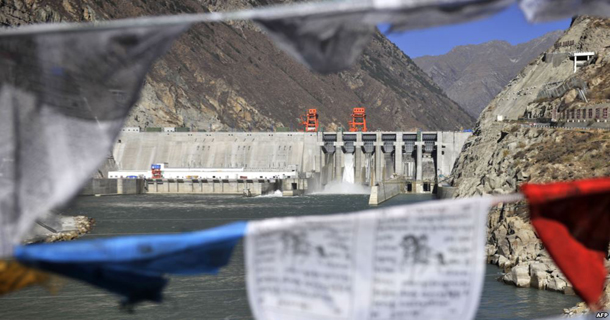China is continuing the construction of six dams along a 20-km stretch of the Kyichu river at Lhasa, a tributary of the Yarlung Tsangpo in the south of Tibet, as part of a controversial 3.5 billion yuan ($550 million, £400 million) project. With an estimated completion date of 2030, one dam of the Lhasa River Project (LRP) is already operational.
The project will add to two existing hydropower dams upstream, the Drikung Hydro Power Station and the Phudo Hydro Power Station or “Tibetan Three Gorges Dam” in Lhundup and Maldro Gungkar counties northeast of Lhasa. Constructed at an estimated $1 billion, according to China Tibet News, the dams constitute the largest engineering project undertaken in the Tibetan Autonomous Region since the 1950s.
While the hydropower dams have been touted as a means of producing lower-emission electricity to reduce China’s overall carbon emissions, the ongoing LRP’s stated aim is to promote tourism by creating a series of artificial lakes under the slogan “making Lhasa enjoyable”. According to Chinese officials, the lakes are designed to contain winter sandstorms, prevent summer flooding, and create a “green environment”.
In spite of these claims and reassurances that local wildlife will not be negatively impacted by the dams, a number of concerns have been raised, including from Chinese sources, about the social, cultural and environmental impact of existing and future projects.
The Kyichu river is a central source of drinking water and irrigation for farming communities from nine counties, and the two hydropower dams are already said to have affected the local population. In 2013 China Central TV quoted local officials who pointed to reduced water levels and stranded fish. Fan Xiao, a Chinese geologist with the Sichuan Geological Society, has warned of further potential effects of the LRP, such as rising water levels and consequent flooding, including within areas of farmland.
Environmentalists have also expressed concern over potential ecological disruption and damage to water quality, given the collective water storage capacity of the six dams when they are complete. This adds to fears about climate change and its effect on the water quality through the continual release of carbon from global warming in the region. Human activities such as dam building could add to this problem. According to Fan, dams slow the river flow and still water is more likely to become polluted.
In the past, dam construction has also been linked to earthquakes. Engineers and geologists have suggested the construction of China’s massive Three Gorges Dam may have triggered the 7.9-magnitude Sichuan quake of 2008. Despite the comparatively small scale of the LRP, the lakes potentially leave Lhasa, which is positioned in a seismically active region, more vulnerable.
Some have questioned whether tourism is the primary motive of the project. Canadian author Michael Buckley has linked the LRP to China’s wider quest for new sources to power its economy and meet water demands elsewhere. “The concern is that eventually dams will become points for water diversion,” says Buckley. China’s dam construction on all the main rivers running off the Tibetan plateau has led Indian geopolitical analyst Brahma Chellaney to describe the country as involved in “the greatest water grab in history”. Concerns are shared by nations downstream whose water supplies depend on these rivers flowing out of Tibet.
It is clear that the Tibetan glaciers are viewed as a point of growth for China’s expanding bottled water industry. With some 30 companies having already been awarded licenses to bottle it by the provincial government in Tibet, the extraction of Tibetan glacier water is likely to increase substantially over the coming years.
Despite the concerns outlined above, no estimates on the possible displacement of people or amount of land flooded by new projects are currently published by China. “We do not have credible environmental and social impact assessments, we have no environmental compliance system, no cumulative impact assessment and no carrying capacity studies” stated Himanshu Thakkar, co-ordinator of South Asia Network on Dams, Rivers and People. Along with the possible effects of climate change “this is being totally ignored”.





 Print
Print Email
Email